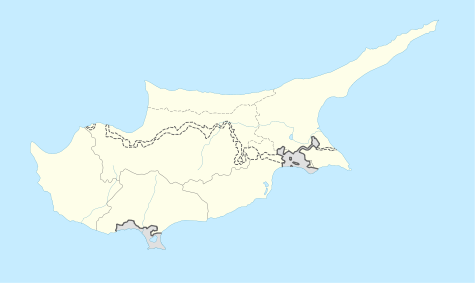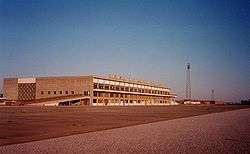Nicosia International Airport
| Nicosia International Airport Διεθνές Αεροδρόμιο Λευκωσίας Lefkoşa Uluslararası Havaalanı | |||||||||||||||
|---|---|---|---|---|---|---|---|---|---|---|---|---|---|---|---|
|
The now-derelict passenger terminal at Nicosia International Airport | |||||||||||||||
| IATA: NIC – ICAO: LCNC | |||||||||||||||
| Summary | |||||||||||||||
| Airport type | Military (and formerly: joint Civil) | ||||||||||||||
| Owner | British Ministry of Defence,[1] | ||||||||||||||
| Operator | Formerly: Royal Air Force Now: de facto United Nations | ||||||||||||||
| Serves | Nicosia | ||||||||||||||
| Location | West of Nicosia, Cyprus | ||||||||||||||
| Elevation AMSL | 722 ft / 220 m | ||||||||||||||
| Coordinates | 35°09′00″N 033°16′38″E / 35.15000°N 33.27722°ECoordinates: 35°09′00″N 033°16′38″E / 35.15000°N 33.27722°E | ||||||||||||||
| Map | |||||||||||||||
 NIC Location in Cyprus | |||||||||||||||
| Runways | |||||||||||||||
| |||||||||||||||
Nicosia International Airport (Greek: Διεθνές Αεροδρόμιο Λευκωσίας, Turkish: Lefkoşa Uluslararası Havaalanı) is a largely disused airport located 8.2 km (5.1 mi) west of the Cypriot capital city of Nicosia in the Lakatamia suburb. It was originally the main airport for the island, but commercial activity ceased following the Turkish invasion of Cyprus in 1974. The airport site is now mainly used as the headquarters of the United Nations Peacekeeping Force in Cyprus.
History
Nicosia was the principal airport for Cyprus from its initial construction in the 1930s as the Royal Air Force station RAF Nicosia until 1974. At first it acted principally as a military airport, and it is still owned by the British Ministry of Defence[1] The landing strip was constructed in 1939 by the Shell Company and Pierides & Michaelides Ltd. Services were provided by Misrair with four-engined DH.86 aircraft.
During the Second World War the airport's facilities and runway were extended by local contractors Stelios Joannou and George Paraskevaides. American bombers used the runway in 1943–44 when returning from the allied bombings of the Romanian Ploieşti oil fields.[2]
After the war commercial services were reintroduced, and by 1948 Misrair, BOAC, Cyprus Airways and MEA were providing regular services.
The facilities provided were limited, with three Nissen huts used as a terminal building housing Customs, Immigration, Civil Aviation, Signals, Traffic and Operational Services. Restaurant services were provided by the NAAFI.
In 1949 the first terminal building was designed and built by the Public Works Department at a cost of £50,000 and was opened in May of that year. The building was then extended together with the aircraft apron in 1959. The building was vacated in 1968 with the opening of the new terminal. The Nicosia Flying Club and other flying organisations continued to use the old building.[3]
The RAF withdrew from the airfield in 1966 due to limited space brought on by vastly increasing civilian aircraft movements. On 27 March 1968 a modern new terminal, designed by the German company Dorsch und Gehrmann from Wiesbaden, and built by Cybarco, was opened, at a cost of £1,100,000 sterling, of which £500,000 was contributed by Britain.[3] [4] The new terminal could accommodate 800 passengers at one time and the parking apron eleven aircraft.
In June 1974 plans were in place for the terminal to be extended and the apron to be enlarged to 16 aircraft of which 2 places were to be for widebodied aircraft.[3] But this was never to happen: on 15 July 1974 right wing Greek nationalists overthrew the democratically elected president of Cyprus, Archbishop Makarios. Nicosia Airport was briefly closed by the coupists, then used on 17 July 1974 to ferry troops from Greece to Cyprus to support the coup against Makarios. Only on the 18 July was it allowed to reopen to civilian traffic, becoming a site of chaotic scenes as holidaymakers and other foreign nationals tried to leave the island.[5] Finally, on 20 July 1974, Turkey invaded Cyprus, bombing the airport heavily and forcing its permanent closure.
The leaders of the Greek Cypriot Community and Turkish Cypriot Community discussed reopening Nicosia International Airport at the beginning of 1975.[6] After the leader of the Greek Cypriot community, Archbishop Makarios, had initially rejected the Turkish Cypriot proposal to reopen the airport to international traffic under joint control,[7] agreement to reopen it was 'in principle' reached during the negotiations in Vienna from 28 April to 3 May 1975.[8] However, discussions by a joint committee set up for that purpose were unproductive.
The last commercial airline flights out of Nicosia Airport took place in 1977 under UN Special Authorisation, when three of the remaining Cyprus Airways aircraft stranded there since the 1974 invasion were retrieved by British Airways engineers and flown to London. One of these, a Trident 2 is now on show at the Imperial War Museum Duxford.
With the Turkish invasion the airport was the scene of some of the heaviest fighting between Cypriot and Turkish forces, which led the United Nations Security Council to declare it a United Nations Protected Area (UNPA) during the conflict. This required both sides to withdraw at least 500 metres from the perimeter of the airport. With the ceasefire signed on 16 August 1974 Nicosia Airport became part of the United Nations controlled Buffer Zone separating the two communities on the island, and it has been inoperable as a fully functioning airport ever since. However, active United Nations helicopters are based at the site, it is the location of Blue Beret Camp which is used as the headquarters for the UN peace keeping mission in Cyprus UNFICYP and it is used as one of the sites for intercommunal peace talks. It is also the home to a number of recreational facilities for UN personnel.
Following the closure of Nicosia Airport a new airport, Larnaca International Airport (LCA), was opened in the Republic of Cyprus in 1975, and in Northern Cyprus the Ercan International Airport (ECN) was opened in 2004, both on former RAF airfields. Paphos International Airport (PFO) was also opened in the Republic of Cyprus in 1983.
There have been some plans for Nicosia Airport to be reopened under United Nations (UN) control as a goodwill measure, but so far neither the Greek nor the Turkish Cypriots have seriously pursued this option.
In 2013 Dr Michael Paraskos of the Cornaro Institute in Cyprus argued that with three other functioning airports in Cyprus the old Nicosia Airport would no longer be needed even in the event of a political settlement on the island. Instead he suggested it should be turned into a tax-free industrial zone, designed to attract foreign high tech firms, and employing Cypriots from both the Greek and Turkish communities on the island.[9]
Incidents and accidents
- On 3 March 1956 a Handley Page Hermes (a Hermes IV G-ALDW operated by Skyways Limited) was destroyed on the ground by a time-bomb in the forward freight compartment. The explosion occurred 20 minutes before the aircraft was due to depart for the United Kingdom with 68 passengers.[10] There were no fatalities.[11]
- On 27 April 1956 an RAF Douglas Dakota was destroyed on the ground by a bomb thought to have been placed by EOKA fighters.
- On 20 April 1967 a Bristol Britannia crashed on approach to the airport in bad weather, 126 killed.
- On 29 January 1973 an EgyptAir Ilyushin Il-18 aircraft (Reg No SU-AOV) crashed into the Pentadaktylos mountain range on approach to the airport killing all 37 aboard (7 crew and 30 passengers).[12]
- On August 29, 1973, a Czechoslovak Airlines Tupolev Tu-104 operating flight CSA531 from Damascus overran the runway upon landing. The aircraft was due to fly onwards to Prague from Nicosia. No fatalities were reported on the flight, and the wreckage of the aircraft is still close to the airport.
- On 20 July 1974, two empty Cyprus Airways airliners (a Hawker-Siddeley HS121 Trident 1E (5B-DAE), and a Trident 2E (5B-DAB)) were destroyed on the ground by the Turkish Air Force during the Turkish invasion of Cyprus.
- On 22 July 1974, 33 people were killed when 20 ageing Nord Noratlas and 10 C-47 Skytrains, of the 354 Transport Squadron "Pegasus", were assigned to transport a Greek commando force to protect the airport from invading Turks. This operation was named Operation Niki[13]
References
- 1 2 House of Commons Hansard Written Answers for 19 Jan 2005 (pt 6)
- ↑ "Civil engineers". The Times Digital Archive (58616; col B). October 27, 1972. p. III. Retrieved 2008-05-02.
- 1 2 3 Kevork K Keshishian (1990) Nicosia the Capital of Cyprus Then and Now ISBN 9963-571-21-2
- ↑ Nathan Morley, Nicosia: Our Other Airport, in The Cyprus Mail (newspaper), 8 November 2009
- ↑ See Colin Smith, ‘None of us expected what happened next’, in The Cyprus Mail, 22 July 2006
- ↑ Special report by the UN Secretary-General on development in Cyprus: UN Docs. S/11624, 18 February 1975, and S/11717, 9 June 1975. See also House of Commons Debates, Vol. 885, Col. 1380, 5 February 1975.
- ↑ United States, Congress, Senate, Committee on the Judiciary, Subcommittee to Investigate Problems Connected with Refugees and Escapees, Crisis on Cyprus: 1975, 1975, p. 53.
- ↑ The final communiqué of 3 May 1975 contained the following: 'Agreement was reached in principle on the reopening of the Nicosia International Airport … A joint committee will be set up by the leaders of the two communities for the purpose of opening the airport for full civilian use (UN Doc. S/11684, 4 May 1975, Annex, and UN Doc. S/11717, 9 June 1975, para. 52)
- ↑ Nathan Morley, 'Bold plan to regenerate derelict Nicosia airport' in The Cyprus Mail, (Cyprus newspaper) 22 September 2013, http://cyprus-mail.com/2013/09/22/bold-plan-to-regenerate-derelict-nicosia-airport/
- ↑ "Civil Aviation: Hermes Sabotage". Flight. 16 March 1956, p.306.
- ↑ "ASN Aircraft accident Handley Page HP.81 Hermes IV G-ALDW Nicosia". Aviation Safety Network. 26 October 2014. Retrieved 2014-10-26.
- ↑ "Egyptian plane crashes since 1970". CNN. January 3, 2004. Retrieved 2007-01-30.
- ↑ Lt. Gen (ret) George Mitsainas "Hellenic Wings at Cyprus", ISBN 960-630-182-6, Athens 2004.
External links
| Wikimedia Commons has media related to Nicosia International Airport. |
- http://www.kypros.org/CyprusPanel/cyprus/nytimes.html
- http://www.kypros.org/Cyprus_Problem/p_latestdevelop.html
- http://www.cyprusairports.com.cy/showpage.php?PageID=232
